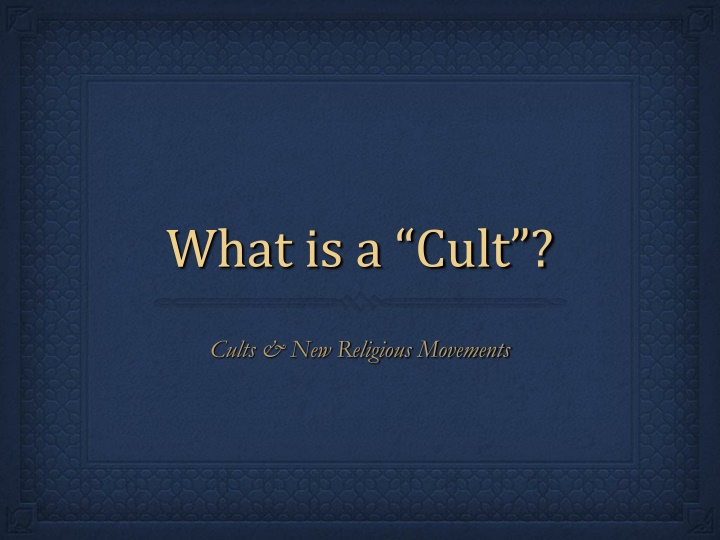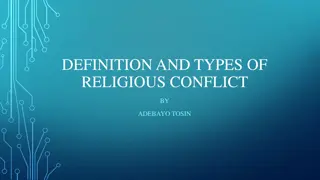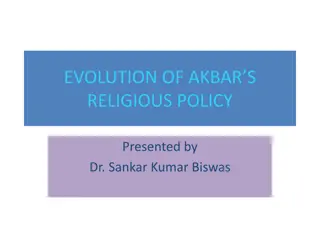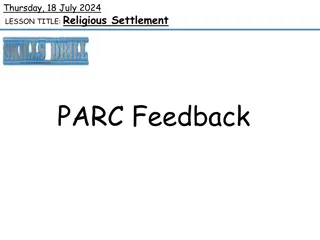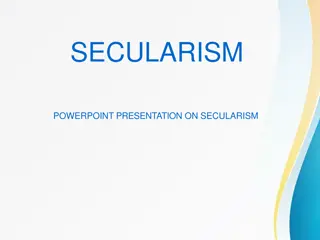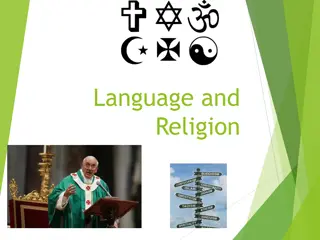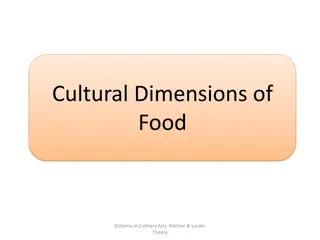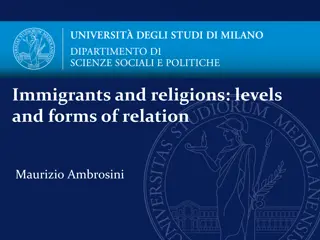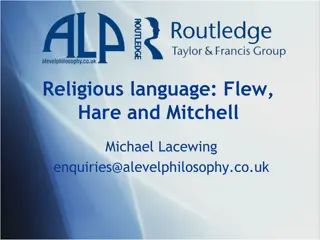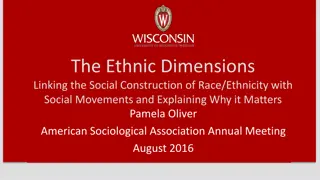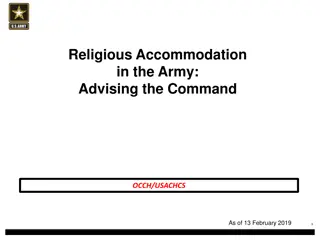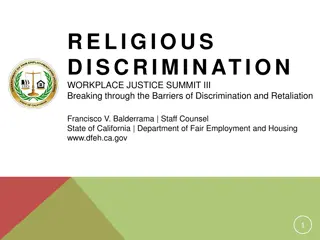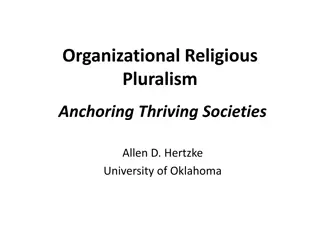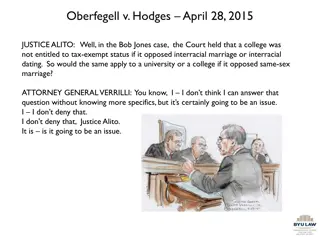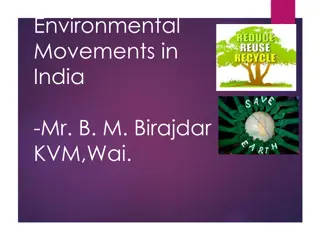Cults and New Religious Movements
Explore the concepts of cults and new religious movements, comparing them to traditional religions. Delve into the defining characteristics of cults, sects, and controversial religious movements. Consider starting your own cult by examining teachings, rituals, authority, and organization. Reflect on the criteria that distinguish a group as a cult and the common characteristics they possess. Reflect on the nature of religion and its components, with insights from various definitions.
Download Presentation

Please find below an Image/Link to download the presentation.
The content on the website is provided AS IS for your information and personal use only. It may not be sold, licensed, or shared on other websites without obtaining consent from the author.If you encounter any issues during the download, it is possible that the publisher has removed the file from their server.
You are allowed to download the files provided on this website for personal or commercial use, subject to the condition that they are used lawfully. All files are the property of their respective owners.
The content on the website is provided AS IS for your information and personal use only. It may not be sold, licensed, or shared on other websites without obtaining consent from the author.
E N D
Presentation Transcript
What is a Cult? Cults & New Religious Movements
Agenda Attendance Defining terms Make-your-own cult What is a cult? compared to a religion? Media attitudes Slide 2.
Preview: Studying NRMs Describe what a cult is in terms of its necessary and typical characteristics. How are the terms Sect , New Religious Movement, High Demand New Religion Alternative Religion Controversial Religious Movement different? What is a cult ? What components does a cult have? What do cults have in common? Are all cults the same? Slide 3.
In this class http://cdn.memegenerator.net/instances/250x250/25464833.jpg Slide 4.
If you started a cult What would it be like? Teachings? Rituals? Authority? Organization? Daily Life? Slide 5.
What would you call a cult ? What qualifies a group to be called a cult? Name some. Necessary characteristics: What must a movement have in order to qualify as a cult ? Typical characteristics: What do cults typically but not necessarily have? Slide 6.
Words dont mean; people mean - Hayakawa Slide 7.
What is religion? What components do religions have? Which of these are necessary (without them it wouldn t be a religion)? Which of these are optional (a religion may or may not have them)? What do religions have in common? Slide 8.
Definitions of religion American Heritage Dictionary: "Belief in and reverence for a supernatural power recognized as the creator and governor of the universe; A particular integrated system of this expression; The spiritual or emotional attitude of one who recognizes the existence of a superhuman power or powers." Durkheim: A religion is a unified system of beliefs and practices relative to sacred things, i.e., things set apart and forbidden--beliefs and practices which unite in one single moral community called a Church, all those who adhere to them. Wallace: a set of rituals, rationalized by myth, which mobilizes supernatural powers for the purpose of achieving or preventing transformations of state in man or nature Geertz: "Religion is (1) a system of symbols which acts to (2) establish powerful, persuasive, and long-lasting moods and motivations in [people] by (3) formulating conceptions of a general order of existence and (4) clothing these conceptions with such an aura of factuality that the moods and motivations seem uniquely realistic. Bellah: "...a set of symbolic forms and acts that relate man to the ultimate conditions of his existence." William James: The very fact that they are so many and so different from one another is enough to prove that the word 'religion' cannot stand for any single principle or essence, but is rather a collective name." Talal Asad: My argument is that there cannot be a universal definition of religion, not only because its constituent elements and relationships are historically specific, but because that definition is itself the historical product of discursive processes. Slide 9.
Small groups: define religion Do not use these words in your definition: spiritual/spirituality belief experience the sacred, the holy, or the transcendent faith mystical Slide 10.
Necessary components Connects humans to a supernatural reality Is organized: Is shared with others has recognized authorities Has rituals Slide 11.
Optional components Teachings: Meaning: what is the purpose of life, the universe, and everything? Salvation: How to escape the basic human predicament Ethics: What is right and wrong? What happens after death? Practices: Rites of passage Expressing devotion: Worship, Prayer, Thanks, Praise, Sacrifice, Appeasement Scriptures Education Service Slide 12.
Religion or something else? What is the difference between a religion and: Spirituality? Spirituality can be individual; Religion is shared with others. (e.g., New Age spirituality) Philosophy? Philosophy ignores the supernatural, or at least supernatural persons. (Confucianism? Scientology?) Cultural Worldview? May not have recognized authorities or rituals. Slide 13.
Sect Sect usually refers to a dissident group that has separated from another, usually mainstream, religion (often proclaiming its intent to recover principles or practices believed to have been present in earlier times but from which the denomination has drifted away), while a cult is a small, intense religious group whose ties to mainstream religion and culture tend to be less pronounced, one that often espouses a belief system not rooted in Christianity or Judaism and often under the personal direction of a single charismatic leader. Slide 14.
Necessary characteristics Fringe (not mainstream in numbers or area) Religious beliefs? Recently begun? High-demands placed on members Slide 15.
(Stereo-)Typical characteristics High-demand Self-sacrifice for the cause Encapsulation (us & them attitudes) Charismatic leader Peculiar scriptures or teachings Difficult to leave? Unreasonable? Aggressive recruiting? Apocalyptic? Violent? Sexually deviant? Slide 16.
Differences between cult and: Sect More established than cult , a branch within a larger religion. New Religious Movement Carries no negative connotations Not everything considered a cult (especially by the ACM) is new. (e.g. gnosticism, Freemasonry) High Demand New Religion Not everything considered a cult puts high demands on its members (e.g., New Age Movement, Wicca). Alternative Religion Who decides what is mainstream and what is not? Does it vary from place to place (Mormonism in Utah; Judaism in Antigonish)? Emergent Religion Slide 17.
Richardson, J. T. (1993). Definitions of Cult: From Sociological-Technical to Popular-Negative. Review of Religious Research, 34(4), 348. http://doi.org/10.2307/3511972 Abstract: This paper examines the theoretical and historical development of the term "cult," from its inception in the work of Troeltsch to more modern delineations of the term in the work of researchers studying new religious groups. The usurpation of the term by popular usage associated with strong negative connotations is discussed, along with efforts by a few contemporary scholars to salvage the term by redefining it in ways which attempt to combine traditional and popular meanings. The futility of this approach is discussed, and the paper concludes with suggestions that scholars should avoid the term and that it should not be allowed to be used in legal proceedings because of its confused and negatively connoted meaning in contemporary society. Slide 18.
Olson, P. J. (2006). The Public Perception of Cults and New Religious Movements. Journal for the Scientific Study of Religion, 97 106. Slide 19.
Biased portrayals of cults Media portrayals Dangerous Devotion video (0:00-5:48) What are proposed as cult characteristics? Counter-Cult Movement: Walter Martin on Christian Cults According to Martin, what makes something a cult? Slide 20.
Jehovahs Witnesses Children of Jehovah video We have guest speakers coming next week. Be respectful and try to understand where they are coming from. To prepare, read the chapter on Jehovah s Witnesses by Ashcraft and Daschke, on the Moodle site. Slide 21.
Next Sociological Issue Read Chapter 1 in Comprehending Cults Write a summary and response, and paste it into Moodle Summary 1 Slide 22.
Next Religious Movement Read the Reading on Jehovah s Witnesses (on Moodle) Make notes on what you notice about what they believe about God The world Humanity The problem The good life Death Come prepared to ask questions of our guests Slide 23.
